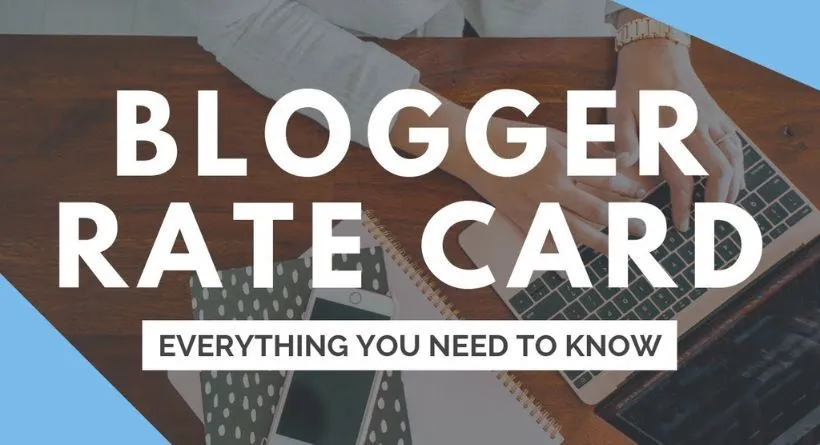Are you a blogger aiming to make money from your posts? If so, you’ve undoubtedly had to deal with the difficulty of haggling prices with prospective sponsors and marketers. It might be difficult to estimate the appropriate cost for your blog entries, so don’t worry! This in-depth lesson will introduce you to the world of blogger rating cards and demonstrate how to make your customized rate card using our helpful template. By the time you finish reading this article, you’ll be armed with the information and resources you need to effectively determine your prices and create collaborative relationships with businesses. So let’s get started and learn how to create a great blogger rating card!
Also Read: How to Do Payroll in Maryland
Understanding Blogger Rate Cards
What is a blogger rate card?
As a blogger, you are always producing informative material for your readers. However, have you ever considered how to assign a value to your labor? A blogger rating card may help with that. A blogger rate card is a written statement of your rates and offerings for sponsored blog articles or brand partnerships. It acts as a reference point for prospective sponsors to comprehend your fees and the value you can provide.
You may build clear and open contact with marketers by making a blogger rating card. By explicitly laying down your terms and expectations, it creates the framework for a professional partnership. A rate card aids prospective customers in navigating your offers and choosing the choices that best meet their requirements, much like a menu at a restaurant.
Why is a rate card important?
For several reasons, having a blogger rating card is essential. First of all, by offering a standardized document that consistently explains your charges and services, it saves you time and energy. Your rate card does the hard work for you so you don’t have to go back and forth negotiating costs with each prospective sponsor.
A rating card, secondarily, demonstrates your competence and professionalism. It presents you as a serious blogger who appreciates the importance of their work and realizes their worth. You may increase the possibility of gaining successful partnerships by providing a well-designed rate card to prospective sponsors.
Finally, a rate card clarifies expectations and prevents miscommunication. It guarantees that you and the brand are in agreement on the deliverables, deadlines, and costs. This openness encourages a positive working environment built on respect and understanding.
Benefits of having a rate card
A well-designed blogger rating card has several advantages. Let’s look at a few of them:
Streamlined Communication: By using a rate card, you may do away with drawn-out negotiations. Your pricing and services are accessible to brands, facilitating effective communication and speedier decision-making.
Pricing Consistency: A rate card guarantees that your pricing structure is consistent. Eliminating the chance of undercharging or undervaluing your services, guarantees that you get paid appropriately for your work.
Credibility Gained: Your brand gains credibility when you use a professional rate card. It demonstrates that you handle your company methodically and establishes you as an authority in your field.
Saving time: You may just share your rate card rather than taking the time to write unique bids for each company. You may use that spare time to produce material of the highest quality.
Having the upper hand in negotiations starts with having a rate card. Based on your experience and the value you bring to the table, it offers you the power to negotiate higher prices or extra benefits. It also serves as a benchmark for negotiations.
After discussing the value of a blogger rate card and the advantages it provides, let’s move on to the next part, where we’ll go further into the crucial factors you must take into account while developing your rate card.
Essential Components of a Blogger Rate Card

Identifying your target audience
You must first choose your target audience before you can begin to create a blogger rating card. Your rate card may be customized to the demands and tastes of your prospective sponsors or collaborators provided you have a clear understanding of who they are. Think about your blog’s industry or specialty, the businesses you’d want to partner with, and the characteristics of your readership.
Also Read: Find the best Payroll Software
For instance, if you operate a fitness blog that caters to health-conscious consumers, fitness gear businesses, supplement manufacturers, or wellness resorts can be your perfect sponsors. Knowing your target market can help you connect your rate card with businesses that appeal to your readership, increasing the likelihood that you’ll land worthwhile collaborations.
Defining your blog’s value proposition
What distinguishes your blog from the numerous others on the internet? You must clearly articulate the distinctive value proposition of your blog to develop a successful rate card. Think about the qualities and attributes that sponsors find important and appealing in your material. Is it your captivating writing style, your in-depth expertise in a certain field, or your aptitude for producing eye-catching graphic content?
To make prospective sponsors understand why they should choose you above other bloggers, you should emphasize your value proposition in your rate card. It demonstrates the advantages of working with you and how your blog may successfully assist them connect with their target audience. Keep in mind that your rate card should succinctly and effectively communicate the value you bring to the table.
Determining your pricing structure
Setting a price for your services may be a tricky balance. Make sure your fees are reasonable, representative of your knowledge and the value you provide, and competitive. However, you should also take prospective sponsors’ spending plans and industry norms into account.
Investigate market standards and examine what other bloggers with comparable reach and impact are charging to decide on your pricing strategy. You may use this information as a springboard for establishing your pricing. Remember that your price may also be influenced by variables like the market niche of your site, engagement metrics, and the time and effort necessary to produce sponsored content.
It’s crucial to find a balance when determining your rates between being cost-effective for companies and paying yourself fairly for your labor. Keep in mind that your rate card should be fair and practical while also conveying professionalism and knowledge.
Outlining available services and packages
The services you provide and the various packages or alternatives accessible to prospective sponsors should be clearly outlined on your pricing card. Take into account all the many ways you may work with sponsors, including sponsored blog pieces, social media campaigns, product reviews, and giveaways.
You can accommodate various budgets and goals that brands may have by offering a variety of services. A simple plan can come with a sponsored blog post and social media shout-outs, for instance. Premium packages might come with extras like video content or special discounts for your audience. To assist sponsors in making wise judgments, specify the deliverables and advantages of each package in clear terms.
Including testimonials and case studies
Testimonials and case studies are effective methods for showcasing the outcomes of prior partnerships and the significance of your blog. Potential partners may feel more confident and trusting if you provide them with case studies of successful campaigns or endorsements from pleased sponsors.
Ask companies you’ve previously collaborated with for reviews or testimonials that emphasize the successful outcomes they experienced as a consequence of your partnership. Add case studies where you discuss actual instances of how your blog aided a brand in achieving its marketing objectives. This testimonial to your past accomplishments may influence sponsors to pick you.
Your blogger rate card will be thorough and persuasive if you include these crucial elements, which will also showcase your value, price, services, and success stories. Let’s go to the next part now.
Step-by-Step Guide to Creating a Blogger Rate Card

Researching industry standards and competitors
It’s essential to undertake careful research on industry norms and your rivals’ pricing before drafting a blogger rate card. To learn more about their prices and services, start by investigating other blogs and influencers in your industry. This study will provide you with a competitive advantage when determining your pricing by assisting you in comprehending the market value for sponsored content in your sector.
Consider aspects like audience size, engagement metrics, and the kind of knowledge shown by your rivals when doing research. You may position your charges appropriately using this information while keeping in mind your distinctive value offer.
To spot any new trends or market shifts, also examine industry publications and articles. You may make adjustments to your rate card overtime to make sure it stays current and competitive by keeping up with the most recent changes.
Choosing the right format and design
It’s time to think about the structure and style of your rate card after you have a good awareness of industry norms and your competitors. Your rate card’s aesthetic appeal is crucial for drawing prospective sponsors’ attention and projecting professionalism.
When selecting a format, think about whether a printed or digital version would best meet your requirements. A paper version might be useful for in-person meetings or networking events, while a digital rate card can be readily sent through email or integrated into your website.
When it comes to layout, choose a simple, eye-catching style that complements your blog’s identity. To retain a professional appearance, use consistent fonts, colors, and formatting across the whole text. Always remember that readability is important, so choose a font size and style that is simple to read.
Customizing your rate card template
You can genuinely make your rating card template your own and highlight your special qualities by customizing it. Start by adding your blog’s name, logo, and contact information to the header and footer. By doing this, you establish a unified brand identity and make it simple for prospective sponsors to get in touch with you.
Create sections on the rate card that explicitly describe your services, costs, and outputs. To organize the content and make it simple to explore, use headings and subheadings. You may, for instance, include areas for various kinds of partnerships, including sponsored blog pieces, social media campaigns, or product evaluations.
Consider providing several bundles or tiers when advertising your charges so that you may accommodate a variety of budgets and goals. This guarantees the clarity of your price structure and gives prospective sponsors the choice that best meets their demands.
Highlighting your unique selling points
What makes you stand out among a sea of bloggers? In your rate card, here is where you should emphasize your distinctive selling propositions. Showcase what makes your site unique and how businesses might benefit from working with you.
If you have a large and active social media following, for instance, highlight the potential visibility and reach your sponsored content may provide. Highlight your authority and influence inside your particular field if you have a devoted following or a specialized area of knowledge.
Don’t forget to concentrate on the advantages and value you provide to sponsors rather than just listing features. Describe how your blog may assist businesses in achieving their marketing objectives, such as increasing website traffic, brand recognition, or sales.
Incorporating persuasive language and emotions
Incorporate persuasive language and arouse emotions in your rate card to make it intriguing and interesting. Describe the advantages and results sponsors may anticipate from working with you using strong adjectives and action verbs.
For instance, you may state, “I create engaging and educational blog posts that captivate readers and drive engagement, helping your brand stand out in a crowded digital landscape,” as opposed to, “I offer sponsored blog posts.”
Also Read: Canvas Tcisd login details for you
You boost your chances of getting sponsors’ interest by appealing to their emotions and showcasing the advantages your blog may have for their brand.
Adding a call-to-action for potential clients
After your rate card, don’t forget to include a clear call-to-action (CTA). A CTA encourages prospective sponsors to go forward and begin working with you. It may be as simple as asking them to get in touch with you so you can talk more about it or so you can create a proposal just for them.
You increase the likelihood that sponsors will become long-term partners by providing a CTA, which makes it simpler for them to get in touch and show their interest.
After reading about the detailed steps for making a blogger rate card, you’re well on your approach to establishing a thorough document that highlights your value, price, and special selling aspects. We’ll examine other pointers and tactics to help you get the most out of your rate card in the next section.
Tips for Optimizing Your Blogger Rate Card

Using language that resonates with your target audience
It’s critical to employ wording that appeals to both advertisers and readers when developing your blogger rate card. Address their needs, difficulties, and ambitions directly. You may connect with them and help them feel understood by using language that is consistent with their interests and beliefs.
Use language that emphasizes sustainability, conscious consumption, and environmental effect, for instance, if your site is about green living and eco-friendly items. This will attract sponsors that share your enthusiasm for spreading sustainability.
Demonstrating your expertise and authority
It’s critical to establish your knowledge and authority on your rating card to differentiate yourself from other bloggers. Communicate with confidence, expertise, and professionalism by using your words and tone. Sponsors will be reassured by your credibility and dependability as a result.
Highlight your accomplishments, including any honors, certificates, or endorsements from professionals in the field. Mention any relevant training or work history that establishes you as an authority in your field. You increase your chances of establishing partnerships by demonstrating your experience to prospective sponsors.
Showcasing previous collaborations and success stories
Including examples of prior partnerships and successes in your rate card is a practical method to increase its credibility. Give examples of particular campaigns you’ve successfully run, your accomplishments, and the benefits to the businesses you’ve collaborated with.
Mention these results on your rate card, for instance, if you worked with a skincare company and saw a large rise in website traffic or a spike in product sales. If you can, quantify the outcomes to provide actual proof of your performance.
Including testimonials and social proof
Social evidence and testimonials are effective methods for establishing credibility and trust. To demonstrate the worth and quality of your work, include endorsements from pleased sponsors or clients in your rate card.
Mention pertinent data like the number of followers you have, your follower engagement rate, or the positive comments your readers have left if you have a sizable social media following or a dedicated audience. These statistics and endorsements confirm your power and the potential effect you may have on a brand’s marketing initiatives.
Regularly updating and revising your rate card
Your rate card for bloggers is flexible. Make it a habit to update and change your rate card often to guarantee its applicability and efficacy. Keep abreast of market developments, business trends, and modifications to your product offers.
Consider reviewing your pricing every six months or once a year to reflect your expanding impact, rising demand, and market shifts. You may improve your offers, highlight new services, or modify prices depending on your growing knowledge by updating your rate card.
Conclusion
Finally, a blogger rating card is a crucial tool for any blogger looking to monetize their work and establish fruitful relationships with sponsors. In this post, we’ve looked at the essential elements and step-by-step procedures for developing a rate card that accurately shows your worth, knowledge, and distinctive selling qualities.
We started by comprehending the foundations of a blogger rating card, including its significance, definition, and advantages. Then, we went into detail about the crucial elements, like identifying your target audience, establishing your blog’s value proposition, deciding on price plans, explaining services and bundles, and including case studies and testimonials.

